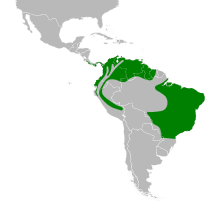Yellow-bellied seedeater
The yellow-bellied seedeater (Sporophila nigricollis) is a species of bird in the family Thraupidae, formerly placed with the American sparrows in the Emberizidae.
| Yellow-bellied seedeater | |
|---|---|
_-NW_Ecuador.jpg) | |
| Male in Ecuador | |
| Scientific classification | |
| Kingdom: | Animalia |
| Phylum: | Chordata |
| Class: | Aves |
| Order: | Passeriformes |
| Family: | Thraupidae |
| Genus: | Sporophila |
| Species: | S. nigricollis |
| Binomial name | |
| Sporophila nigricollis (Vieillot, 1823) | |
 | |
| Synonyms | |
| |
Taxonomy and systematics
Hooded seedeater
The hooded seedeater was a proposed bird species described by Austrian ornithologist August von Pelzeln as Spermophila melanops in 1870. The only known individual was heavily moulted and caught in October 1823 from a flock of other seedeater species at the edge of a lake 15 kilometres north of Registro do Araguaia, Brazil. It is now considered to be either a hybrid or an abnormal specimen of the yellow-bellied seedeater. The bird had a black crest and throat, the upperparts were olive and the underparts showed a dingy buff. In contrast, a typical yellow-bellied seedeater has pale yellow underparts and the black colouring extends to the upper breast.
Distribution and habitat
The yellow-bellied seedeater is found in Central and South America from Costa Rica to Bolivia. Its natural habitats are subtropical or tropical high-altitude shrubland, pastureland, and heavily degraded former forest.
Threats
One study in Brazil, estimated that 16,800 yellow-bellied seedeaters are illegal caught and sold as pets annually.[2]
References
- BirdLife International (2012). "Sporophila nigricollis". IUCN Red List of Threatened Species. 2012. Retrieved 26 November 2013.CS1 maint: ref=harv (link)
- Regueira, R. F. S., & Bernard, E. (2012). Wildlife sinks: Quantifying the impact of illegal bird trade in street markets in Brazil. Biological Conservation, 149(1), 16-22.
